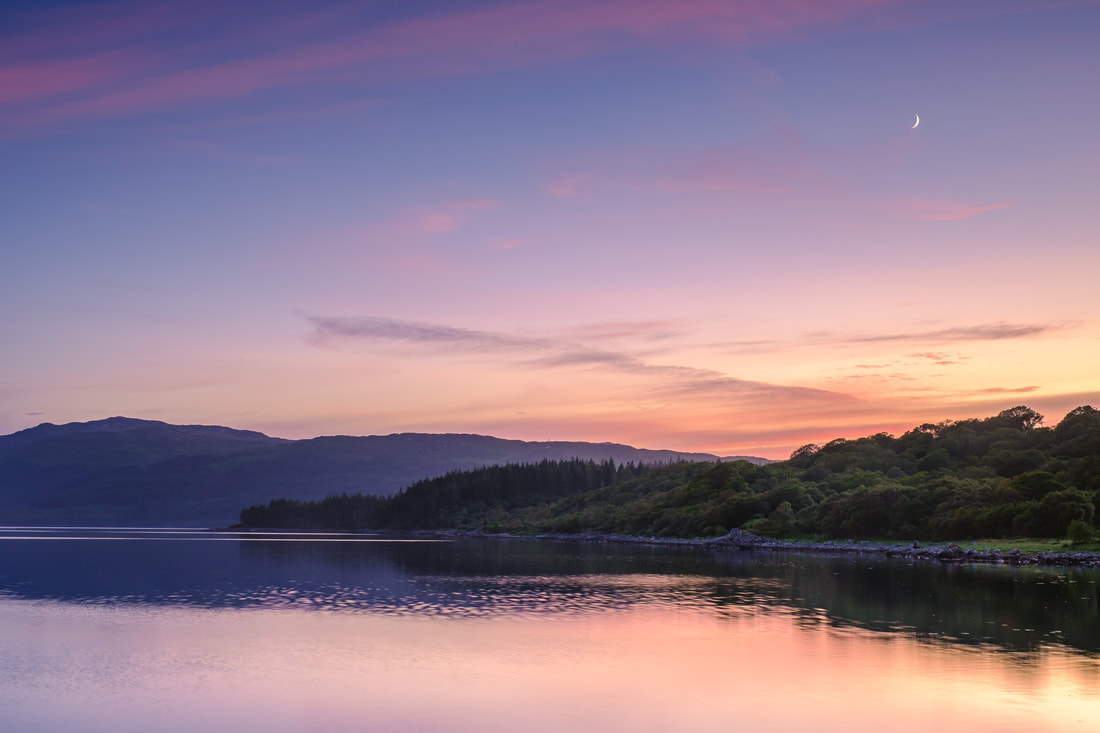|
It’s June and summer is finally upon us. This means milder weather and longer days, with the longest day of all taking place on 21 June, the day of the Summer Solstice. As the Sun sets so late and rises so early, it barely gets dark at this time of year. Indeed, this month’s image, which was taken shortly before 11:00 pm on a night close to the Summer Solstice, shows just how light it can be. I spent quite some time then, sitting on a small promontory facing west over Loch Sunart and watching the slimmest of crescent moons traverse the twilit sky as midnight approached. There sure is something magical about these light nights and it is little wonder that the summer solstice and midsummer have been celebrated for time immemorial This year, the summer solstice occurs on 21 June at 10:13 am. It is the exact moment when the North Pole is at its maximum tilt towards the Sun, when the Sun reaches its highest position in the sky and when the Sun rises at its closest to north-east and sets at its closest to north-west.
Although the summer solstice is a precise moment in time, many people refer to it as the “Longest Day” because it is the day when the number of hours of daylight are at their maximum and the number of hours of night are at their minimum. For instance, on 21 June this year, our sunrise here on the Peninsula will be at 4:27:36 am and our sunset will be at 10:22:23 pm, giving us 17 hours, 54 minutes and 47 seconds of daylight. While the summer solstice marks the astronomical start of our summer, it has traditionally been celebrated in Scotland as midsummer, the halfway point in the growing season and a time when people hoped for bountiful harvests. The celebrations began as a Celtic fire festival when bonfires would be used to bless crops and beasts. Animals would be walked around the fire in a sun-wise (clockwise) direction and torches would be lit from the main fire to then be carried around homes and fields, also in a sun-wise direction, to bless families and the crops. Also, people used to gather herbs at this time, and either scatter them into the fire to complete the ritual, wear them along with flowers to ward off evil spirits, or place them under their pillows as good luck charms to manifest good dreams. Birch branches were sometimes hung above doors for protection. This was also believed to be the best time to collect honey from beehives, which is why the first full moon in June was called the “honey moon”. Unsurprisingly, this became the traditional month for weddings. With the coming of Christianity, many pagan midsummer celebrations were moved to the feast of St John the Baptist on 24 June, with bonfires remaining central to them. People would light the bonfires on midsummer eve and then stay up until midnight to welcome in midsummer day. They continued to gather herbs and flowers to protect themselves from evil spirits and one of the most powerful plants was ‘chase-devil’, which is now called St John’s Wort. It was used in potions and woven into garlands because people believed that this would provide them with protection. Finally, herbalists continue to use St John’s Wort in medicines to this day. It contains many chemicals that act on messengers in the brain that regulate mood and there is some strong scientific evidence that it is effective for mild to moderate depression.
2 Comments
|
AuthorHi, Archives
July 2024
Categories
All
|
Steven Marshall Photography, Rockpool House, Resipole, Strontian, Acharacle, PH36 4HX
Telephone: 01967 431 335 | Mobile: 07585 910 058 | Email: [email protected]
Telephone: 01967 431 335 | Mobile: 07585 910 058 | Email: [email protected]
All Images & Text Copyright © 2024 - Steven Marshall - All Rights Reserved


